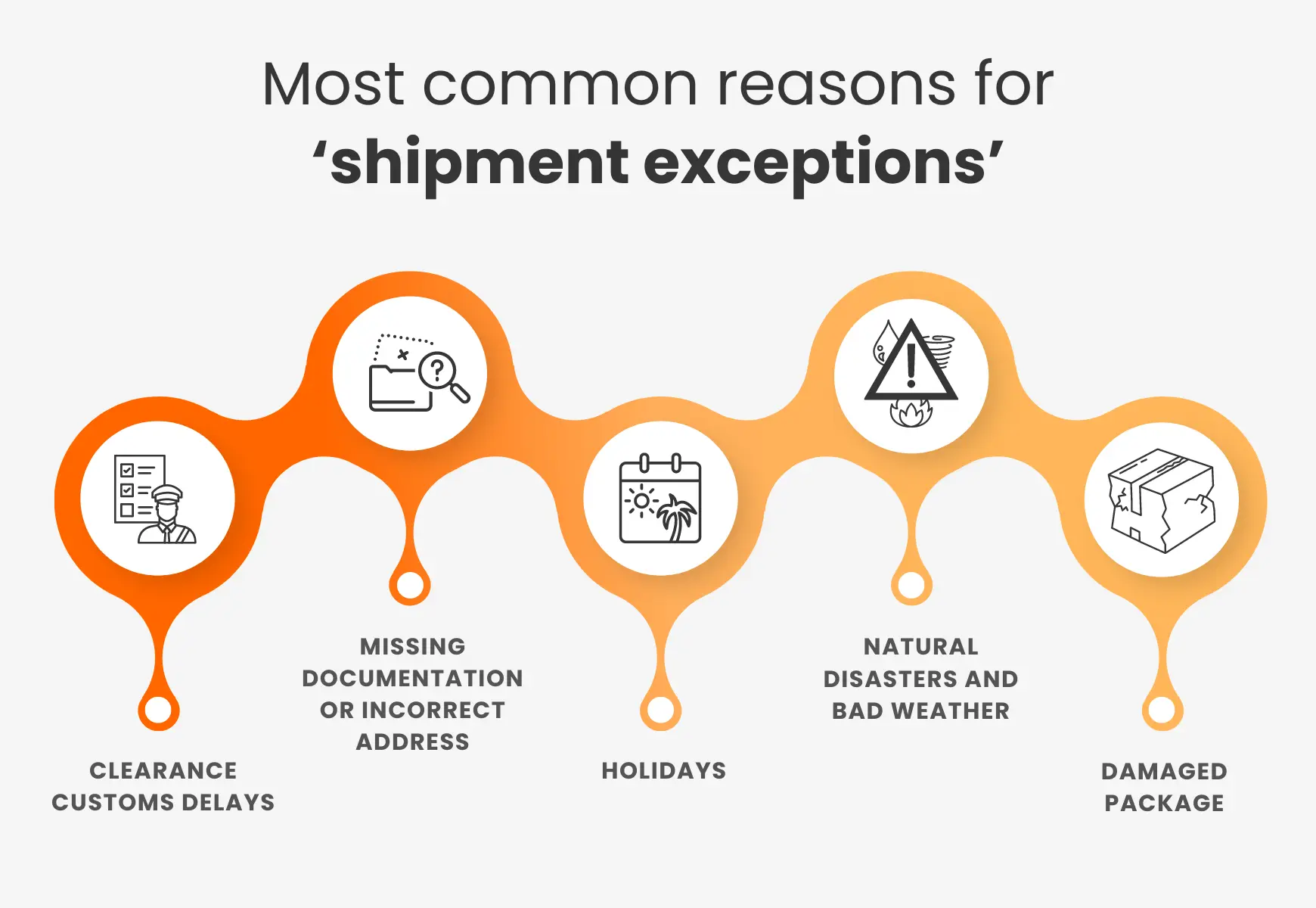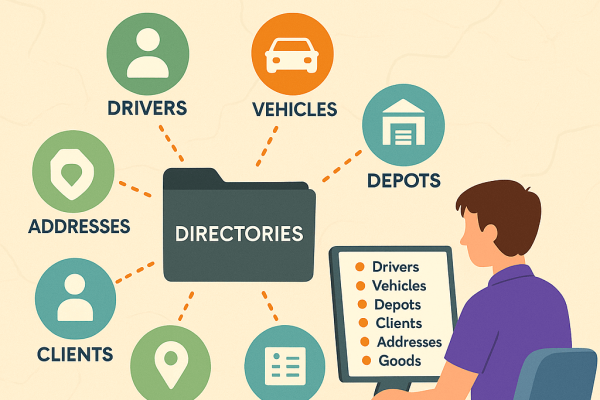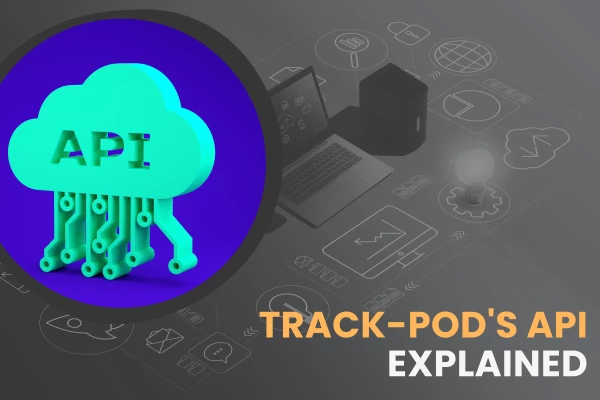Shipment exception - delivery status explained + Free Logistics Terms PDF

by
Alisa Cvilij
June 18, 2024
The phrase ‘shipping exception’ is often, if not always, dreaded because it usually means bad news concerning the delivery trajectory process.
The ‘shipping exception’ term refers to the delivery status of a certain package that needs to be delivered to the recipient but is delayed for some reasons that are out of the control of the delivery shipping service.
And yes, ‘shipping expectations’ are indeed one of the unfortunate aspects of the delivery business.
This delivery status was invented to connect with other terms like ‘out for delivery,’ ‘in transit,’ ‘shipped,’ etc.
Still, many need clarification about the true meaning of this phrase and are constantly browsing the internet, looking to find a more concrete definition of the term.
In this blog post, we’ll explain everything you need to know about the delivery status ‘shipping exception, what causes this delivery status, and more details you might be curious to know.
Also important, inside this blog article, you will learn how to communicate and explain this status to your customers when deliveries you are managing get into shipment exceptions.
Now, let's elaborate on the topic in the sections below.
Table of content
- What does shipment exception mean?
- Can delivery logistic businesses prevent shipping exceptions?
- Why is technology software essential to delivery businesses?
- What are the consequences of ‘shipment exception’ delivery status?
- When ‘shipment exceptions’ usually occur, what are the most common reasons for this status?
- How long do ‘shipping exception’ statuses last?
- How do you communicate shipment exceptions and shipment delays to your clients?
- The importance of knowing all the delivery logistics terminology
- Are packages with ‘shipment exception’ status still getting delivered to recipients?
- Do ‘shipment exceptions’ impact delivery businesses?
What does ‘shipment exception’ mean?

The definition for ‘shipment exception’ is a delivery status in the delivery logistic supply chain and refers to a situation when a package is temporarily delayed and stuck in the delivery process.
The delivery status ‘shipment exception’ signals a problem with the package that should be delivered, and it cannot be distributed to the recipient based on the original delivery schedule.
Delivery logistic businesses use this status to mark a package that, for some reason, has been stopped from proceeding in the regular delivery flow to reach the recipient's address.
Note: When a package is labeled as ‘shipment exception,’ it doesn’t necessarily mean it will arrive late - sometimes, even if it is marked as such, the package might still reach the recipient’s location on the expected delivery date.
Can delivery logistic businesses prevent shipping exceptions?
There is a simple method for delivery businesses to avoid shipping exception statuses: to handle the deliveries internally.
This means they should use their delivery team to reduce the unpredictable surrounding package whereabouts. However, this outlook requires the recipient’s location close to your delivery warehouse hub.
Why is technology software essential to delivery businesses?
Let’s begin by first saying that in the US only, the term ‘shipment exception’ is searched around 5,8k times monthly.
Ahrefs confirms this information as one of the most popular SEO (search engine optimization) tools, indicating that there is quite a high search volume for that phrase.
Consequently, this search volume reflects the widespread concern among delivery logistics businesses and recipient individuals regarding managing unpredicted events in the shipping process.
With that in mind, the demand for advanced technology software solutions such as Track-POD is massive.
Delivery management software options like Track-POD offer innovative features like automated notifications, live status updates with real-time tracking, and predictive analytics to handle occurrences like ‘shipment exception’ statuses.
It is software solutions like Track-POD that, once fully implemented, delivery businesses can focus on and address the most common challenges associated with shipment exceptions.
These challenges are identified through search data, offering proactive management while improving overall customer service satisfaction, which is the heart of each business, often leading to positive word-of-mouth referrals.
And yet another benefit of software like Track-POD, when statuses like ‘shipment exceptions’ occur, is that it can offer end-to-end visibility to customers. Hence, they have full transparency of the journey of their shipment.

What are the consequences of ‘shipment exception’ delivery status?
When packages are labeled ' shipping expedition,’ several consequences fall on delivery logistic businesses.
If you think about this more thoroughly, ‘shipping exception’ delivery statuses create a problem for delivery businesses, shipping carriers, and customers.
Below, we’ll discuss the most obvious ones;
- Delivery businesses end up paying the price for delayed, stolen, or lost packages - shipping exception statuses come with a hefty price tag, specifically referring to the refunds issued for shipping fees.
- Upset customers when the packages they should receive as planned are delayed, provoking them to leave a bad review for that particular delivery company.
- Shipping couriers are bombarded with customers' calls or SMS messages about package delays, sometimes making them feel frustrated because they deal with customer complaints.
When ‘shipment exceptions’ usually occur, what are the most common reasons for this status?
Various factors impact package delivery flow and disrupt the expected delivery status procedure.

The fact is, nobody can predict some situations and occurrences once a package leaves the warehouse. The ‘shipment expedition’ status can occur to any package, and these are the most prominent reasons why delivery businesses label packages with the term:
Regarding international shipments, delivery delays are common because packages can be stuck at customs clearance due to regulatory issues in the country where that package is being processed.
Good to Know: Sometimes, customers might also see a label saying ‘regulatory agency clearance delay.’ This status is closely related to ‘shipping exception’ because it refers to a package delayed due to customs regulations for international shipping.
- Missing documentation or incorrect address
Sometimes, packages with wrong or missing information about the final delivery address of the recipient are flagged as ‘shipment exceptions’ because the courier cannot deliver the package.
In the peak holiday seasons like Christmas, Easter, and other prominent holidays, packages might get stuck at some point in the delivery trajectory process. That's how your Thanksgiving message is getting the ‘shipment exception’ status.
- Natural disasters and bad weather
Nobody can predict nature, and when there are hurricanes, floods, storms, heavy rain, or snowstorms, the delivery of packages can be disrupted for obvious reasons, causing shipment delays and labels like ‘shipment exception’ to those packages.
Packages can be damaged when they are in transit and held for inspection. Usually, when this occurs, they are returned to the sender of the package.
Important Note: If a package comes damaged, recipients should contact UPS customer service to initiate a claim. They might be asked to submit documentation as proof (photos) that the package you received is damaged.
How long do ‘shipping exception’ statuses last?
No exact timeline demonstrates the duration for the shipping exception status of a package. It all depends on what caused the delay of that particular package.
However, typically, shipment exception statuses last around seven days.
How do you communicate shipment exceptions and shipment delays to your clients?
Handling shipment expectation statuses is hard work, let alone the responsibility of delivery businesses to communicate such delays to their clients.
To convey this information, delivery businesses must know the ‘starter kit’ of comprehensive explanations that would bring to effective management of these statuses:
1. Provide customers with tracking numbers for their package delivery.
Package tracking numbers are an invaluable source when packages are labeled as ‘shipment exceptions’ because they can provide customers with real-time information about the stats and whereabouts of their package.
2. Utilize delivery management software to gather real-time updates on shipment exceptions.
There are not enough words to emphasize the importance of implementing delivery management software in delivery businesses, especially in such cases. This software can not only.
3. Be clear with recipients about any delays (proactive communication)
Successful delivery services that stay on top of their ‘game’ and want to keep growing their delivery logistic business must notify customers about any delays concerning their package.
The proactive approach with customers in situations like these can turn a potentially negative experience into a good one.
4. Offer solutions
Delivery businesses can offer customers possible resolutions in situations like these. They can offer reshipment or replacement of the package, refund or credit for the value of the package if for some odd, exceptional reasons it cannot be delivered to them.
Or, if the package is insured, they can offer insurance claims to be filled and guide them through the process.
The importance of knowing all the delivery logistics terminology
We cannot put a bigger accent on how essential it is to know all the terminology circulating in the delivery business environment.
In addition, it is crucial to know how to communicate it correctly to your customers whenever their packages get a certain delivery status. This is when logistics terminology glossaries come in handy; everyone in the business niche should consider downloading one.
Feel free to download a PDF version of a logistics terminology glossary and look into the most used terms and phrases in the delivery logistics field below.

Are packages with ‘shipment exception’ status still getting delivered to recipients?
Usually, if not always, they are delivered even when a package is marked as a ‘shipment exception.’
Even though there are delays in a package reaching its final destination on time, it will still arrive at the recipient’s location.
However, there might be some rare occasions when they might not be delivered to the recipient.
In cases like these, once the recipient concludes that their package has the ‘shipment exception’ status for more than seven days and hasn’t been delivered to them, they must contact the local delivery service hub to get answers on the problem with that particular package.
Do ‘shipment exceptions’ impact delivery businesses?
Yes, they do impact delivery businesses a lot, causing lots of consequences such as:
- Bad business reputation
- Waisted time
- More costs in delivery management
- Reduced customer loyalty
- Unhappy customers
- Legal liability
Wrapping up
Understanding the meaning of ‘shipment exceptions’ in delivery logistics is one thing, and handling them is completely another.
One should always have access to logistics terminology glossaries to avoid confusion when phases like these come up because they explain most, if not all, of the prominent terms used in delivery logistics.
Also, shipment exceptions are just delivery status labels when a package is stuck for some reason, and its delivery is delayed - at least, they are up till the moment they are dealt with.
Last but not least, delivery companies that haven’t yet implemented delivery management software are missing out on solutions that can help them handle shipment exception situations in the best way possible.
About The Author
Alisa Cvilij
Content Marketer at Track-POD. Passionate about building meaningful and helpful content for the readers.









